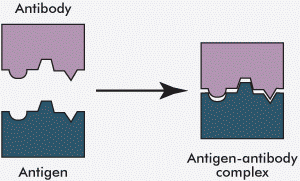Introduction
Humoral response
Common flu
Cell-mediated response
Introduction
Different cells have different molecules presented on their surface to the immune system. These are often protein-based and enable the identification of:
–pathogens
-cells from other organisms of the same species
-abnormal body cells
-toxins
The specific immune response is split into humoral immunity and cell-mediated immunity. Humoral is to do with the blood and antibodies. Distinguishing between an antigen and an antibody is very important.
Antigen = protein or carbohydrate foreign (not normally present) to a host’s organism
Antibody = protein made as a response to detecting an antigen which binds to the antigen and prevents the pathogen from the host.

Immunity against invading pathogens is a crucial part of maintaining health. The body has adaptations which prevent invasion by pathogens, as well as processes in place to deal with those that manage to penetrate the body’s primary defenses. The skin and mucous membranes (e.g. mouth) are examples of such defenses. Sweat contains lysozyme which is an enzyme that breaks down bacterial walls. The skin flora is made up of all the microorganisms that live on the skin without causing disease. They populate the surface of the body, so invading pathogens can be stopped in their tracks by the resident flora.
Connective tissue, tears, mucus and ciliated epithelium also help protect against infection. Connective tissue forms during scarring and alongside blood clotting, it maintains the barrier against infection. Tears and mucus contain digestive enzymes that maintain eye and respiratory system health by disintegrating microorganisms and keeping a hostile environment to prevent infection. Ciliated epithelium has hair-like protrusions that wave to move out particles that are inhaled for example. They also act in…
